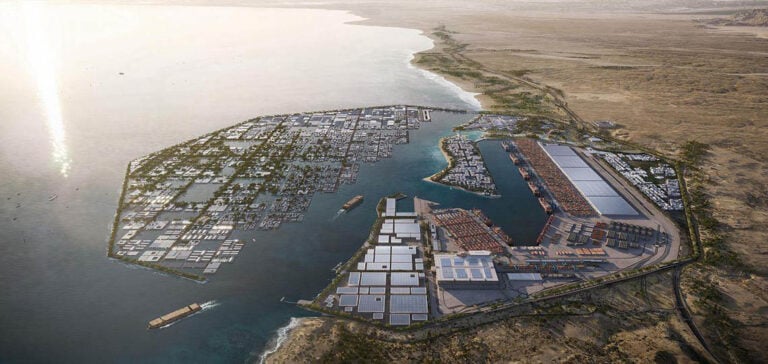Neom’s green hydrogen plant, billed as the world’s largest in its field, is preparing to welcome its first wind turbines, marking a significant turning point in the evolution of the energy industry. According to David Edmondson, CEO of Neom Green Hydrogen Company (NGHC), this historic milestone begins with the receipt of the first wind turbines at the Port of Neom, ready for installation on site by the end of the week. The value of this $8.4 billion plant lies in its use of solar and wind power to produce up to 600 tonnes of green hydrogen per day by the end of 2026, with a clear export focus. At a time when Saudi Arabia, as the world’s leading crude oil exporter, is facing criticism for its role in the global energy transition, this venture represents a significant shift.
Wind and Solar Power for Green Hydrogen
Neom’s plant is based on the promise of producing green hydrogen, a clean energy source, by electrolysis of water, using exclusively renewable energies such as wind and solar power. Hydrogen produced in this way is considered “green” because its production process generates no CO2, making it an important contributor to the fight against climate change. Saudi Arabia is thus seeking to diversify its economy and reduce its dependence on fossil fuels, while becoming a key player in the global energy transition.
A Solution for Transport and Heavy Industry
The green hydrogen produced at Neom will be converted into green ammonia to facilitate transport, then reconverted into green hydrogen at its destination. This form of hydrogen can be used as a fuel in a variety of sectors, including transport and heavy industry. According to NGHC, the use of this green hydrogen in the heavy-duty truck sector could save up to five million tonnes of CO2 per year compared with diesel trucks or buses currently on the road, equivalent to less than 1% of Saudi Arabia’s annual greenhouse gas emissions.
This breakthrough comes at a crucial time, just before the start of the COP28 climate negotiations in Dubai. Saudi Arabia, while remaining a major player in the fossil fuel sector, is striving to demonstrate its commitment to the energy transition and the reduction of CO2 emissions. This ambitious project in Neom is a significant step in that direction.
Green Hydrogen Challenges
Green hydrogen is still a fledgling industry, with relatively high costs and uncertain demand. However, Edmondson is optimistic about the importance of this technology in helping companies achieve their net zero emissions targets. Saudi Arabia has also announced its goal of carbon neutrality by 2060, demonstrating its determination to play a key role in the fight against climate change.
Neom’s green hydrogen plant represents a major milestone for Saudi Arabia, demonstrating its commitment to a cleaner, more sustainable energy future. This initiative demonstrates that even traditional players in the oil industry can play a leading role in the global energy transition. As the world gathers to discuss the planet’s climate future at COP28, Saudi Arabia’s advances in green hydrogen point to a promising future in the fight against climate change and the promotion of more environmentally-friendly energy sources.
Final Analysis
Neom’s green hydrogen plant is much more than an industrial facility. It represents a strategic shift by Saudi Arabia towards a cleaner, more environmentally-friendly energy future. This initiative, which is in line with international climate negotiations, illustrates the importance of green hydrogen as an alternative to fossil fuels. As the world’s leading crude oil exporter, Saudi Arabia is demonstrating its determination to diversify its economy while helping to reduce greenhouse gas emissions. At a time when green hydrogen is emerging as an essential tool for achieving net zero emissions targets, Saudi Arabia is playing a key role in this crucial transition for our planet. The eyes of the world are on developments in Neom, and the world’s energy future looks greener than ever.






















